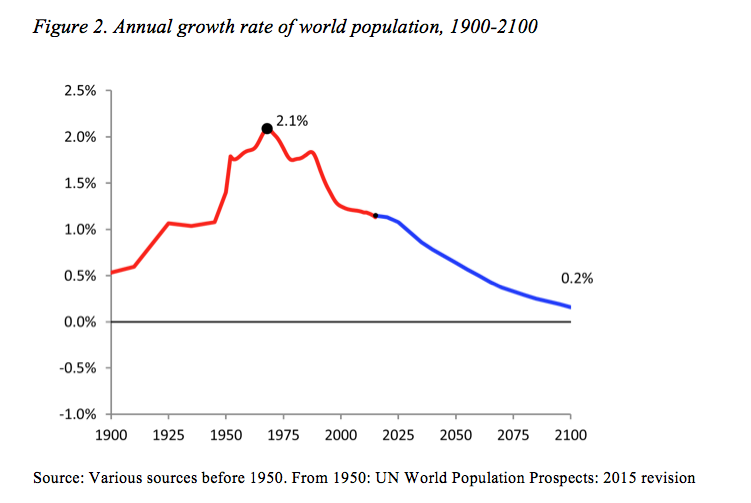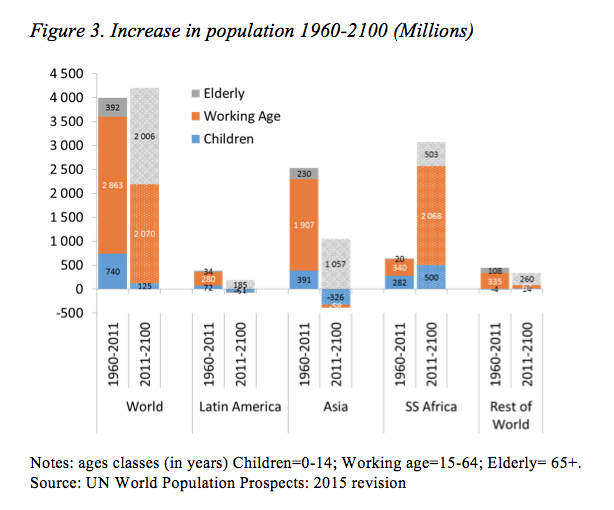When the world population reached 7 billion in 2011, it marked the amazing addition of 4 billion people in just over 50 years, the world having attained the 3 billion milestone in 1960.
The United Nations projects that world population will top 11 billion by 2100, roughly the addition of another 4 billion people (United Nations Population Division, 2015). By 2100 world population growth will probably be near an end.
In considering whether the world can absorb another 4 billion people, it is interesting to look back at the past and note some important differences between the 4 billion that will be added between 2011 and 2100 and the 4 billion added between 1960 and 2011. The next 4 billion will be old rather than young, will be in Africa rather than Asia, and will take almost a century to arrive rather than 50 years. It will raise some new challenges, although the experience of the last 50 years gives room for optimism about the world’s ability to support it.
The past, present, and future of world population growth
It is hard to overstate how extraordinary the demographic experience of the last 50 years has been. The world will never again add 4 billion people in 50 years. World population will never again double in 39 years, as occurred when the world grew from 3 billion in 1960 to 6 billion in 1999. It took thousands of years to reach a population of 1 billion. As seen in Figure 1, from the 1960 population of 3 billion, the time it took to add each subsequent billion was 14 years, 13 years, 12 years, and another 12 years, arriving at 7 billion in 2011. The time between billions has now started to increase. The world population growth rate has been falling since its peak in the 1960s, as seen in Figure 2, and should continue to do so throughout this century.
While there is uncertainty in these projections, it is smaller than one might think. Fertility rates are near or below replacement level in most regions, with the important exception of Africa. Most current population growth in the world is “inertial,” the result of growth in the childbearing population due to rapid population increase in previous decades. The childbearing population will decline in most regions in coming decades. This means that population growth will slow down throughout the world, even if there are no further declines in the average number of children born per woman. Declines in mortality, which were the main driver of population growth in the 1960s, cannot contribute much to future population growth, since death rates are low in all regions and will tend to increase rather than decrease as populations age. The main source of uncertainty is Africa, where fertility rates have fallen more slowly than in other regions, and where it is difficult to predict the pace of fertility decline in coming decades.
An important source of optimism about the world’s ability to support an additional 4 billion people is the success in supporting the previous 4 billion. The unprecedented population growth of the last 50 years did not produce the social and economic problems that were predicted when the world reached its peak population growth rate in the 1960s (Lam 2011). Rather than mass starvation, every major world region has seen food production grow faster than population. Even in Africa, where population growth has been the fastest and economic growth has been disappointing, food production per person is 14% higher today than in 1961. The proportion of the population in poverty has declined in every developing region. There have been large increases in education, with a narrowing or elimination of the gender gap in schooling, during a period in which school-age populations grew at unprecedented rates. While many problems remain, improvements in living standards in the last 50 years should be a source of optimism about the world’s ability to support another 4 billion people.
Four billion more people but no more children
If we compare the world’s 3 billion people in 1960 with the 7 billion in 2011, the additional people consist mainly of children and young adults. The first bar of Figure 3 shows how each of three major age groups grew between 1960 and 2011. Comparing the 2011 population to that of 1960, the additional 4 billion people in 2011 can be broken into 740 million children (0-14), 2.9 billion working-age adults (15-64), most of them in younger working ages, and 400 million elderly (65+). This is consistent with the impression that a rapidly growing population is a young population. Note that many of these “additional” 4 billion people, including all those who were over 65 in 2011, were already in the population in 1960, and thus were not literally new additions between 1960 and 2011. I am simply taking the difference between the two populations and thinking of the difference as the “additional” 4 billion, which can then be decomposed by age and region.
Using this same approach to compare the 7 billion of 2011 to the 11.2 billion of 2100, the age distribution of the additional 4.2 billion people looks very different. The second bar in Figure 3 shows that it can be broken into 2 billion elderly, 2 billion working-age adults (mostly older working ages), and only 200 million children. In fact, if we look only at children aged 0-4, their number is projected to be smaller in 2100 than in 2011, even though the total population is over 4 billion higher.
The next 4 billion will also come from different regions than the previous four billion. Figure 3 shows that the previous increase included almost 2 billion working-age Asians, 400 million Asians aged 0-14, and almost a billion working age adults in other regions. The 4.2 billion additional people in 2100 compared to 2011 will include almost zero children or working-age people from any region other than sub-Saharan Africa. There will be roughly an additional 3 billion Africans – 2.1 billion working-age, 500 million children, and 500 million elderly. The remaining 1.1 billion can be broken into 1 billion elderly Asians, another 450 million elderly in other regions, offset by a 350 million decline in the number of children and working-age adults outside of Africa.
Looking at Figure 3, it is important to realize that the world added almost 3 billion people to the working-age population between 1960 and 2011, a 160% increase that was absorbed amazingly well in the regions where the growth occurred. This was a massive shock to the global labor force, and is important in understanding the job dislocations that took place in industrialized countries during the period.
The world will add another 2 billion people to the working-age population in this century, all of them in Africa. While it is staggering to realize that sub-Saharan Africa will need to add about 2 million jobs per month to keep up with the growth of the working-age population in 2040, Asia and Latin America have produced jobs at similar rates in recent decades. The big question is whether Africa can repeat the impressive job-generating capacity observed in other regions.
One of the biggest challenges of the next 4 billion people is that roughly 2 billion of them will be aged 65 and over. While it is well known that populations of all regions are aging, it is sobering to realize that half of the additional 4 billion people in 2100 will be in ages traditionally associated with retirement. The world has managed to absorb rapidly growing numbers of children and young workers in the last 50 years with surprising success. Absorbing 2 billion additional elderly poses a different kind of challenge. Fortunately we have almost a century to absorb them, along with 2 billion additional working-age Africans. This is almost twice as long as it took for the world to grow from 3 billion to 7 billion, a reason for optimism that the world will be able to support another 4 billion people.
The world faces many challenges in this century, and the addition of another 4 billion people surely exacerbates them. Feeding the population will require continued increases in agricultural productivity, comparable to the unprecedented increases of the last 50 years. Environmental problems, especially climate change, pose enormous challenges that do not have easy solutions. There are potential shortages of fundamental resources such as water. The purpose of this discussion is not to minimize these challenges, but simply to point out some of the ways in which 21st century population growth will differ from that of the previous 50 years. Some of these differences, such as the slower rate of increase, should make it easier to absorb the next 4 billion people than it was to absorb the previous 4 billion. Other differences, especially the fact that half of the next 4 billion will be over age 65, will make the challenge greater.
References
Lam, David (2011) “How the World Survived the Population Bomb: Lessons from Fifty Years of Extraordinary Demographic History,” Demography, November 2011, 48(4): 1231-1262.
United Nations Population Division. (2015). World population prospects: The 2015 revision [Database]. Retrieved from (Note: All projections are based on the UN’s Medium Fertility Variant Projections.)





